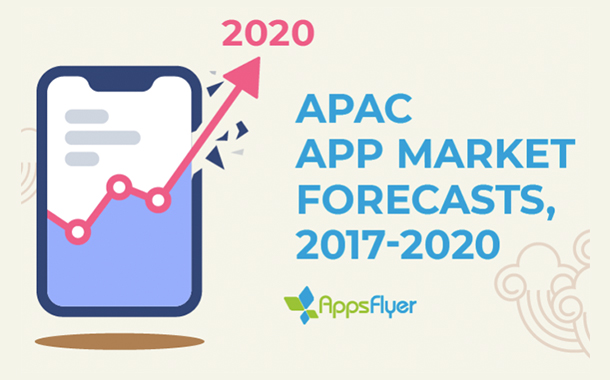With the mobile surge in full swing across the globe, marketers who have adopted a mobile-first approach are uniquely positioned to drive the most success for their brands. With an estimation by Zenith that mobile will claim over 30% of the worldwide advertising space by 2020, we can see why.
Within mobile, there is an increased focus on apps as the ultimate destination to drive user engagement and foster brand loyalty. In parallel, marketers are heavily investing in user acquisition through app install ads.
AppsFlyer is predicting that app install ad spend will rise by 70% by 2020, accumulating to a staggering $64.1 billion. Growth is expected across the globe — in North America, Europe, and Latin America where it will hit $12.9, $10.9, and $8.5 billion by 2020, respectively.
Global Rise in App Install Ad Spend Driven by APAC Growth
Given the exciting dynamics in the mobile space, it is especially important to keep an eye on one of the most lucrative regions for apps and mobile: Asia Pacific, home to the booming Indian and Chinese markets. A leader in both scale and growth rate, according to our findings, APAC shows significant potential for the next few years. Let’s take a closer look at what this means.

The Asian market as a whole is one to pay attention to, both in terms of investment in mobile marketing and, of course, the sheer scale of users in this region.
While on the quest for the highest value users, marketers can expect to make higher investments as the rewards of doing so also increase. From our data, this region is predicted to hold the largest quantity of ad spend and the second fastest growth rate, leaping 1.8x from 2018 to reach $30 billion in 2020. This rate is second only to Latin America, but occurs on a 3.5x higher scale, far ahead of most of the world.
Non-Organic Installs
In installs alone, APAC is expected to own 50% of the global total by 2020, which is 3x more than in any other region.
In addition to an overall commanding market share, APAC is also expected to see a 2.4x leap in the number of installs between 2017 and 2020. This rate very closely matches the Asian growth rate of mobile ad spend, which is also good news for marketers making high investments and expecting high rewards.
Why are app marketing budgets expected to grow in APAC?
There are a number of emerging trends which lend themselves to the boom in mobile ad spend and installs. We’ve highlighted the most prominent insights for 2019 below:
China Explosion. Coming as no surprise then or now, China is the dominant leader in terms of both downloads and consumer spend. Always maintaining a strong international presence, China’s potential as an app market has jumped exponentially in the last year or two and is expected to hit 120 billion downloads and $62.4 billion in consumer spend by 2022, according to AppAnnie.

Despite the benefits to be reaped from this high-profile country, China comes with its own set of challenges, including an entirely separate ecosystem for Android with hundreds of app stores, and a media space dominated by local players. Marketers seeking to enter into this market must be well-prepared and armed with appropriate business, cultural, and social knowledge, as well as ready to deal with tough bureaucracy for gaming apps, in order to succeed.
India Rising. While many of the Asian Pacific markets are powerful, there are several key players among them, the most surprising of which may be India. Dominating as the fastest-growing app economy in the world, India has particularly seen an influx of mobile activity this year.
According to The Economic Times, the country experienced a 41% revenue growth between 2017 and 2018, as well as ranked number one in Q1 2018 for combined iOS and Google Play app downloads. Given its fast-paced take over in the mobile economy, this is the prime time to take advantage of the momentum and ride the Indian wave of this hungry consumer market.
While the average revenue per user (ARPU) in the country is significantly lower compared to others in both APAC and the world, the real strength of the Indian market comes from the volume of app downloads and user activity it generates. Although only 36% currently own smartphones, according to Statista, the number is expected to rise by around 30% over the next 2-3 years. Combined with a robust ad tech ecosystem, increasingly more data-driven marketers, and low CPIs, the opportunity in the Indian app market overall is significant.
Southeast Asia joining the mobile game. Mobile device view time, according to Kantar, has become particularly more pronounced in this region. This is especially true for Thailand, Malaysia, and Indonesia, where 3.9, 3.7, and 3.4 hours are spent on these devices, respectively. Compare these view times to the Asia-Pacific average of 2.7 hours, despite higher downloads, in-app activity, and revenue from other markets, like China and India. In terms of app marketing, we can see significant activity in Indonesia among eCommerce apps, while Vietnam is experiencing massive growth in the gaming vertical.
Cheap, powerful devices. As mobile becomes more relevant to the global market, new devices, from companies like OnePlus, Xiaomi and Huawei, are being increasingly more released which offer similar capabilities as higher-end Android and Apple devices but with a much friendlier price tag.
The fact that high-quality access to the internet through mobile apps is more affordable means that a large number of new users have started, and will continue, to appear in the Asia Pacific’s developing countries. An already-large market opportunity is continuing to grow.
Mobile-first market. In few other places around the world has mobile taken off the way it has in APAC. Many mobile users are highly engaged with their devices and its capabilities — including for payments — making it a “mobile-first” region, and even “mobile-only” in some key country markets.
According to data from Reuters, mobile use in three of the top Asian markets has reached or is approaching 60%. However, it is also important to note that this trend makes these users increasingly more difficult to engage with given their higher standards as a result of increasing tech savviness.
The rise of stronger infrastructure. The last year has particularly seen a rise in stronger devices and affordable data packages, as well as the emergence of stronger cellular infrastructures like 4G and 5G. These systems can support heavier video and music streaming apps with greater flexibility and bandwidth, especially in India, as well as multiplayer online games.
The support of such emerging infrastructures, as well as cheaper data packages and the greater accessibility of smartphones and apps for developing populations, has meant an influx of heavy downloads and app activity predicted to continue into the future.
Key Takeaways
- App install ad spend keeps growing with huge momentum, specifically jumping 2.5x from 2017 until 2020 in the Asia-Pacific region.
- With time, install and ad spend growth alike will both remain robust but gradually decrease.
- Coming as no surprise, the competition in the mobile ecosystem will continue to bring the heat. For this reason, marketers should become much more data-reliant to get the competitive edge they need. Being prepared against the competition is especially relevant in the key market of China.
- The combination of stronger cellular infrastructure, the rise of cheap and powerful mobile devices, more apps, staggering mobile use in key markets, and more users makes the Asia-Pacific market particularly significant for boosting app volume and reaching wider audiences.
- While marketers continue to inform increasingly more thoughtful marketing strategies and see subsequent revenue growth, fraudsters also continue vying for a piece of the pie. This reinforces the necessity of effective and ongoing fraud protection.
- Those apps who serve as ad publishers besides their own functionality are well positioned to ride the momentum of the universal growing ad spend and generate greater in-app ad revenue.

















